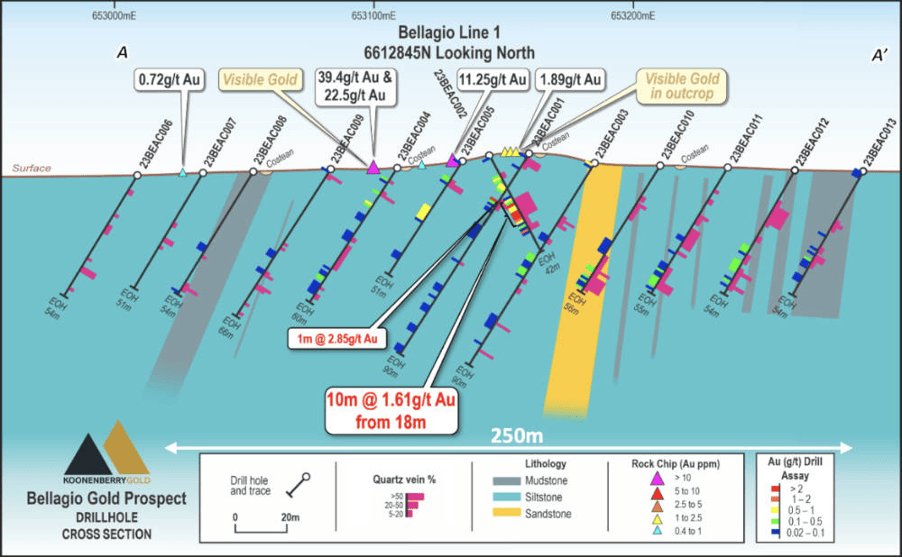‘Potentially significant mineralised system’: Drilling at Koonenberry’s Bellagio gold prospect uncovers best bedrock gold result, more assays to come

First drill holes at the Bellagio Gold Prospect have defined indications of gold mineralisation over a 300m strike that remain open in all directions. Pic: via Getty Images.
- Koonenberry’s maiden drilling at Bellagio Prospect returns 10m at 1.61g/t gold intercept from just 18m
- Quartz veining intersected over a 300m strike, remains open in all directions
- Drilling also hints that fresh rock below current drill holes could host higher-grades and widths of gold
- Assays pending for a further 54 holes over six drill traverses
Koonenberry Gold’s maiden drilling proves there’s still gold to be found at its namesake project in NSW after intersecting very encouraging bedrock mineralisation topping out at 1m at 4.47g/t gold at the Bellagio prospect.
The 2,060km2 Koonenberry gold project is thought to be an extension of Victoria’s rich Stawell Zone that has recorded historical gold production of more than 163t.
Koonenberry Gold’s (ASX:KNB) decision to test the previously undrilled Bellagio prospect came after work to follow-up on a promising regional rock chip sampling result uncovered compelling targets for gold exploration.
Notable pieces of evidence include a project-high assay of 39.4 grams per tonne (g/t) gold from a re-sample of the initial discovery quartz vein outcrop, induced polarisation returning moderate chargeability anomalies coincident with the resistivity features, and Bellagio having a favourable interpreted structural position.
Having three indicators in the same spot at Bellagio — high grade rock chips at surface, anomalies underneath, and the right rocks to host deposits — is very promising.

Encouraging gold intercepts
The first batch of assay results from the maiden drilling program has now validated the company’s decision to test Bellagio, returning a top intercept of 10m grading 1.61g/t gold from a down-hole depth of 18m including 1m at 4.47g/t gold from 24m.
Gold mineralisation on this initial drill section is associated with hydrothermal quartz veining, which has been intersected over a 300m strike and remains open in all directions.
Notably, widespread gold anomalism has been observed across a broad +250m zone, particularly towards bottom of hole, indicating supergene depletion in the highly weathered upper saprolite and the presence of a potentially significant mineralised system.
Koonenberry said that in similar geological settings, the fresh rock below the base of oxidation can host significantly higher tenor, width and continuity of mineralisation than in the highly weathered upper saprolite.
“We are very encouraged by these initial drill results from the first ever drilling program at Bellagio,” Managing Director Dan Power said.
“Gold mineralisation has been intersected underneath the outcropping quartz veins and the intercept of 10m at 1.61g/t gold from only 18m downhole represents the best bedrock gold result at the Koonenberry project to date.
“Significantly, there is also a very wide zone of anomalous gold (0.02 – 0.5g/t gold) in adjacent drillholes, particularly towards the bottom of hole.
“This gives us further encouragement in this greenfields exploration setting, particularly as this drill program has only tested the highly weathered upper saprolite where the true tenor, width and continuity of the gold mineralisation may be underrepresented.”
More results and deeper drilling planned
Koonenberry expects to receive assays from the remaining six drill traverses of 54 holes this month.
It is currently planning follow-up drilling, which may include additional aircore drilling to assess the size potential of the system and deeper RC and/or diamond drilling to assess the fresh rock potential.
This article was developed in collaboration with Koonenberry Gold, a Stockhead advertiser at the time of publishing.
This article does not constitute financial product advice. You should consider obtaining independent advice before making any financial decisions.
Related Topics

UNLOCK INSIGHTS
Discover the untold stories of emerging ASX stocks.
Daily news and expert analysis, it's free to subscribe.
By proceeding, you confirm you understand that we handle personal information in accordance with our Privacy Policy.








